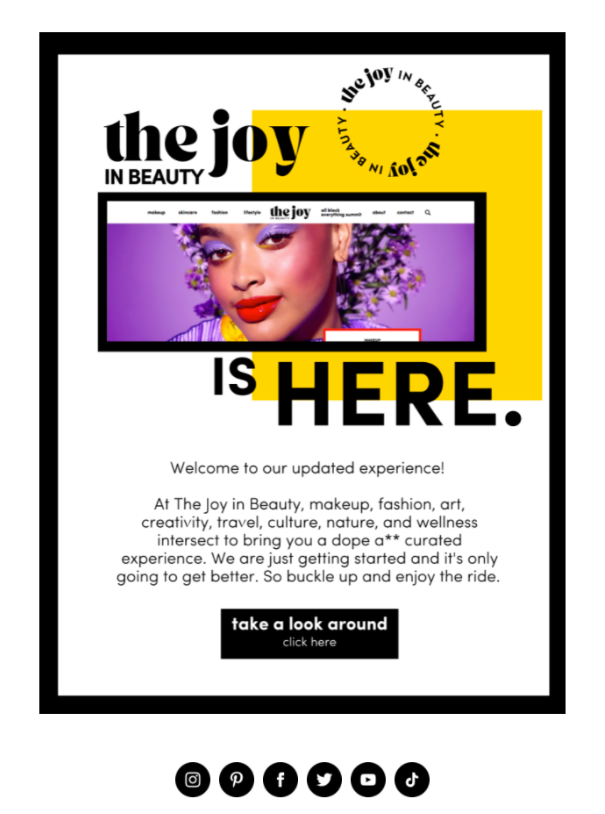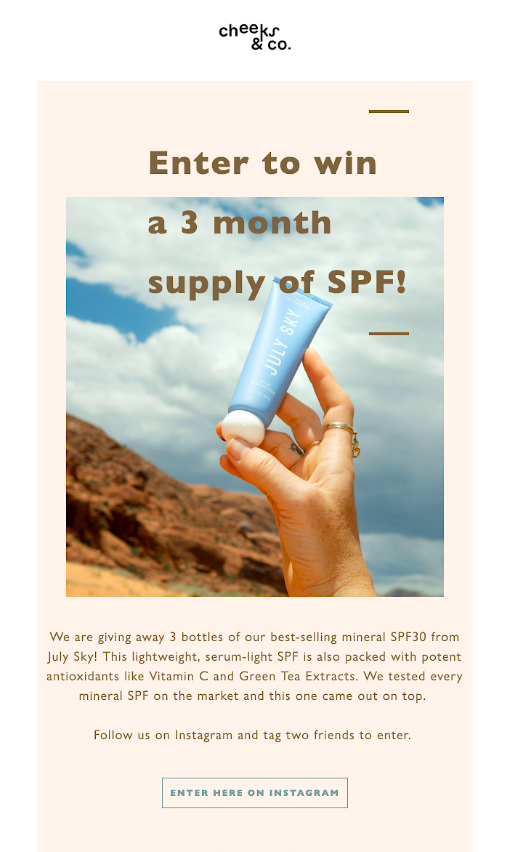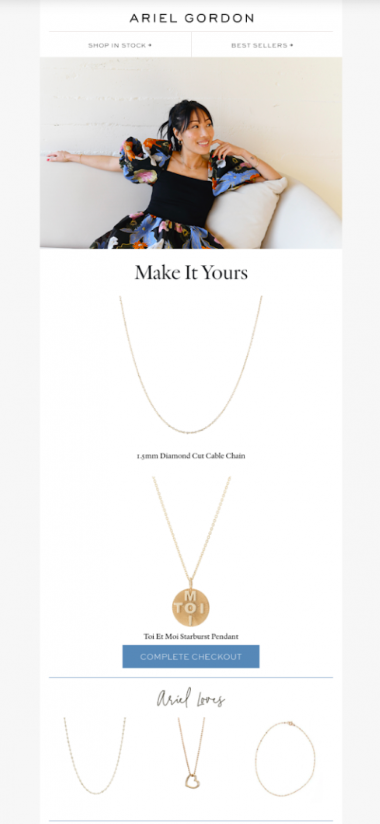12 SMB ecommerce marketing strategies to level up your sales and engagement
Table of Contents Jump to:
Jump to:
Table of contents
Are you ready for more customers to discover your small business? Do you wish your existing customers would visit more often and spend more when they do? It’s time to ramp up your ecommerce marketing game.
Let’s say you’re on the hunt for vegan cookie recipes. After searching online, you see an ad at the top of the results page for a vegan bakery. Below that are several results with recipes from the same bakery.
You click through to check out the recipes, simultaneously discovering this new business. You don’t buy anything on your first visit, but you do sign up to receive emails and quickly receive a $10-off coupon in your inbox.
The next day, you see an ad on social media for the same bakery. You remember your coupon and decide to visit the website again before placing an order.
These are all ecommerce marketing strategies in action, and they can all work together to take your business to the next level.
In this article, we’ll dive into 12 such strategies used by small and medium-sized businesses (SMBs). We’ll explore why each strategy works and give you a few tips on how to execute each tactic within your own company.
Get unlimited email sends & subscribers with Flodesk
We’ll never increase pricing because your email list is growing
What is an ecommerce marketing strategy?
An ecommerce marketing strategy is a plan that’s used to promote an online store or business. Most ecommerce marketing strategies are designed to increase traffic to your online store or website and then convert that traffic into paying customers.
As an SMB, you’ll likely want to use a combination of ecommerce marketing tactics both on and off your website to get the best results. Also, consider using marketing strategies that promote a specific product or service along with those that promote your business as a whole.
12 SMB marketing strategies for ecommerce
- Improve your email campaigns
- Promote and leverage user-generated content
- Run a small influencer marketing campaign
- Run a competition
- Think local
- Optimize your site for mobile
- Build with SEO
- Create original content
- Use PPC advertising
- Use social media
- Run retargeting campaigns
- Send upsell emails
1. Improve your email campaigns
As an ecommerce business, you’re probably already doing some kind of email marketing, right? The question is, how are your campaigns performing?
Besides the well-known ROI of “$42 for every dollar spent,” a well-executed email marketing strategy can:
- Boost sales and conversions. 80% of consumers are more likely to buy from a business that offers personalized experiences—and you can create such experiences with email marketing. Every email you send to customers is an opportunity to show they’re not just a number in your contact list, but a real person you know and connect with.
- Keep your business top of mind. Sending regular marketing emails and newsletters to your customers reminds them of all the great products or services you offer—keeping your business top of mind when they’re ready to make a purchase. Check out these ecommerce newsletter examples to get things rolling.
To make sure you’re getting all these benefits, use the following strategies to improve your campaigns:
Personalize your subject lines
You can boost open rates by 22% just by using personalized subject lines. You could do this by simply including the customer’s name or mentioning something unique to them—like an order confirmation number or the name of the item they left in their cart.
Segment your audience
The ability to segment your audience is one of email marketing’s most powerful tools, allowing you to hyper-personalize your communications so they’re always relevant and valuable. Did you know that segmentation can increase your revenue by 760%?
Wondering what exactly segmenting means? Just think of your entire audience as a whole pie. When you segment your audience, you’re cutting the pie into slices. Then, you can send specific emails to specific slices instead of the whole pie.
Let’s say you have a form on your website where people can opt-in to receive a free pricing guide. You can automatically add these subscribers to a segment called “free pricing guide.” They’re still part of your whole pie (“all subscribers”), but they’re also grouped in your contacts list as your “free pricing guide” segment.
Now, you can automatically deliver your “free pricing guide” email and even automate a workflow to send a hyper-relevant, personalized email a few days later that says, “Hi [name]! You downloaded my free pricing guide, so I thought you’d like this content guide too.”
A button in your email that says “Buy now” or “Click here” is going to convert much better than “Click here to buy it now.” Plus, long button CTAs tend to wrap on mobile devices, making them look broken.
Monitor your metrics
Staying on top of your marketing metrics lets you know when specific areas need attention. For example, if you’re using email marketing to promote your business, your open rate tells you how many people are opening your emails, and your click-through rate tells you how many people are following your CTA links and buttons.
If your open rate is low, you can improve it by optimizing your subject line, sender name, and preheader/preview text. If your click rate is low, you can make sure it’s easy for customers to take action by testing your email on multiple devices.
Conduct frequent A/B testing
What works for one audience or campaign doesn’t necessarily work for another, so it’s important to run frequent A/B testing on your subject lines, CTAs, images, body copy and more. With subject lines, you can test for things like length, tone and word choice. Then take a look at your open and click-through rates to see what works best with your readers.
Use pre-designed templates to create a good user experience
How you design your emails directly impacts the user experience and engagement rates. Fortunately, you don’t have to be a designer to create well-designed emails—you just need good ecommerce email templates.
If you’re using Flodesk, you’re in luck: we have an extensive template library to choose from, and you can customize each template for your brand! Check out this template customization tutorial for more information on how to do it.
Grow your list organically (don’t buy it)
Your best subscribers are the ones who are genuinely interested in your products and intentionally signed up to receive your emails. If you buy email lists, your recipients might not even know who you are, let alone be interested in your products.
Buying an email list usually translates into a high bounce rate, a high number of spam flags and frequent unsubscribes—all of which drag down your sender reputation. Wondering how to get more organic subscribers? Check out how to build an email list in 11 steps.
2. Promote and leverage user-generated content
User-generated content (UGC) is content customers share about a brand based on their own experiences, opinions and decisions. UGC can be anything from videos to social media posts to online reviews.
Since UGC shows real-life experiences from real customers, it’s highly valuable for ecommerce brands—with 93% of consumers saying UGC is very helpful in their decision-making process.
Jen Zapp, director of marketing at Stamped, explains the value of UGC this way: “Without the physicality of a brick and mortar store, customers heavily rely on product descriptions, images, and reviews to validate buying decisions.”
This can be especially important as an SMB ecommerce business since you often have limited name recognition. You can collect user-generated content in a number of ways:
- In a post-purchase email. After customers buy something, include an email asking for reviews or other UGC as part of your post-purchase email sequence.
- On your website. Your ecommerce site should make it easy for customers to leave reviews and other content like images or videos.
- Using branded hashtags. These make it easy for customers to share UGC on social media and even easier for you to find.
Once you’ve set up systems to collect UGC, it’s time to promote and leverage its power using the following channels:
- Social media. UGC posts on social media have a 35% higher engagement rate than branded content.
- Product pages. Customers spend a lot of time reading product reviews. Make sure your product pages feature as much UGC as possible, from written reviews to real-life images of your products.
- Email sequences. Email marketing is a great way to weave in UGC, from welcome emails to abandoned cart emails.
3. Run a small influencer marketing campaign
Just because you can’t afford the top influencers with millions of followers doesn’t mean you should write off influencer marketing as a whole. Data shows that small micro-influencers (those with less than 100,000 followers) have a 700% higher engagement rate than mega-influencers.
Plus, small influencers are much more affordable, often taking free products in exchange for mentions. The best way to find these influencers? Check your social media pages and branded hashtags and find people who are already interacting with your brand.
Then, identify the ones with the highest levels of engagement and activity and reach out to offer them an influencer opportunity.
4. Run a competition
Running a competition like a giveaway or social media contest is another marketing strategy for small ecommerce brands. Most companies set the following goals when running a competition:
- Building brand awareness. Competitions can help introduce your brand to new people, quickly growing your email list and number of social media followers.
- Boosting engagement. Competitions are great for generating buzz and giving people a reason to interact with your brand. You can measure engagement based on social comments, tags, and shares.
- Increasing sales. The increased levels of interaction with your brand during competitions often lead to more sales. And at the end of the day, that’s what it’s all about!
Here are a few competitions you can use to achieve the above goals:
- Like/share/comment to win contest
- TikTok hashtag challenge
- Instagram photo contest
- Tag a friend contest
- Follow to win contest
- Recurring draw contest
- Sign up to win contest
- Voting contest
- Sweepstakes
- Photo caption contest
5. Think local
Local marketing isn’t just for brick-and-mortar businesses. It can be a good strategy for ecommerce brands too, particularly SMBs with ties to the communities in which they’re located.
A recent study by Mint found that 70% of consumers are supporting local businesses by shopping either online only or with a mix of online and in-store shopping.
The study also found that Millennials and Gen X consumers are most likely to support local businesses by shopping online. People who choose to shop in-store at small businesses are mostly over the age of 45.
So, think about the communities that surround your office or warehouses. Run local promotions to let people know that you’re a small business operating in their community. Advertise in local radio stations and newspapers, join online community groups and the local chamber of commerce, and advertise or participate in local events.
6. Optimize your site (and emails) for mobile
Mobile ecommerce sales are projected to surpass $430 billion in 2022—almost double 2019’s total. Plus, over 58% of all online visits in 2021 were from smartphones.
That said, many sites are still built primarily for desktop and PC users, creating a poor user experience via mobile and lagging mobile conversion rates. Optimizing your ecommerce website for mobile is a smart way to take advantage of traffic that’s already there but not converting.
To get the most out of this strategy, focus on improving speed and ease of use by incorporating responsive design elements into your website and emails. Responsive design ensures your layout adjusts based on the viewing device, taking mobile users into account from start to finish.
Fortunately, you don’t need an entire IT department to make this happen. Flodesk offers several mobile-responsive email templates that look great on any device. Or, you can create your own template from scratch—making it easy for small business owners to send stunning, mobile-optimized emails to their customers.
Tips for optimizing for mobile:
- Choose a website builder or email marketing software that supports responsive design—like Flodesk
- Design for mobile devices first, desktop second
- Try a single-column layout
- Add alt text and descriptions to all images in case the email client fails to load your images
- Use smaller image sizes
Get unlimited email sends & subscribers with Flodesk
We’ll never increase pricing because your email list is growing
7. Build with SEO
SEO, or search engine optimization, is all about getting your website or product pages to show up at the top of the search results, driving more organic (unpaid) traffic to your store. Backlinko found that the #1 organic search result page is 10x more likely to receive a click than the page in spot #10.
Some of the best ways to build traffic with SEO include:
- Doing keyword research and then including your selected keywords in your page URLs, product descriptions, and blog posts
- Optimizing your website structure to make it easier for search engines to crawl
- Creating a good user experience on your website
- Building backlinks from other reputable websites
As a small business owner, tackling all the details of SEO can feel downright overwhelming. But don’t worry—there are lots of ways to make it happen. For example, you can take an SEO course designed for small businesses with a small budget. You can also invest in an external SEO consultancy or even bring an SEO strategist onto the team (if you have the budget).
8. Publish original content
Along the same lines as SEO, creating original content is all about capturing organic traffic. Whatever your customers are searching for, you want to have content that answers their questions.
Let’s say you run an online health and nutrition coaching business. Before your ideal customer even starts looking for a coach, they’re probably searching for information related to health and nutrition like:
- Healthy 30-minute dinners
- Best 5k training plan for beginners
- How to start running
- Low-carb meal plans
If you publish original content that answers these questions and promote it well, your ideal customers will find your business before they even know they’re looking for you.
Original content can be blog posts, videos, podcasts and more. You can also guest post on other websites to get your name out there and piggyback on their search ranking.
9. Use PPC advertising
Creating original content is a great strategy for driving organic traffic, but it often takes time. It’s usually a long-term strategy for most businesses. While you’re waiting, pay-per-click (PPC) advertising is another way for SMBs to capture search traffic. It’s also a good strategy to use in tandem with your content once it’s up and running.
Forty-five percent of businesses with less than 50 employees invest in PPC. And that number jumps to 74% when it comes to small businesses with 50 employees or more.
One of the reasons PPC is so popular among SMBs is because it’s efficient and budget-friendly. As the name implies, your ad will still show up in search results, boosting brand awareness, but you only have to pay if someone actually clicks through the ad.
Social media is a great marketing tool for SMBs. Not only is it essentially free to use, but it’s also a great way to engage with customers, build a following and drive traffic to your website.
Research from Hootsuite shows that 44.8% of global internet users use social media to search for brand-related information. Plus, over half of global internet users between 16 and 24 use social media to research brands.
As an SMB, you can use social media to:
- Drive traffic to your website
- Sell products directly on social media channels
- Communicate and engage directly with your customers
Here are a few tips to get the most out of your social media strategy as a small business owner:
- Be authentic and showcase your personality
- Collaborate with others
- Use short-form video content
- Post user-generated content as much as possible
- Post often and regularly
11. Run retargeting campaigns
On average, ecommerce stores only convert around 5% of their traffic, which means most people aren’t buying something on every site visit. It doesn’t mean that they aren’t interested, however, which is where retargeting comes into play.
If you’ve ever shopped online, you’re likely familiar with retargeting ads. Let’s say you’re browsing a new website for shoes but end up leaving without buying anything. The next day, you start seeing ads for the same shoes while you’re reading an article online.
Then you see another ad for the shoes while you’re scrolling through Facebook. The next time, you see the ad while you’re watching a video on YouTube. Finally, you realize these shoes are pretty great, so you head back to the website and make a purchase.
Social media platforms like Facebook and Instagram run retargeting ads. You can also run Google ads through the Google Display Network. Keep in mind that marketers using three or more channels for any one campaign earn a 494% higher order rate than those using a single-channel campaign.
12. Send upsell emails
An upsell email is an email you send to existing customers to persuade them to purchase more than they originally intended. Often, this means encouraging them to buy a related item or upgrade to a higher-priced version of your product or service.
Upsell emails are an extremely effective way for small online businesses to boost revenue, with sales generated by product recommendations accounting for 10-30% of all ecommerce revenue. Here are some tips for sending killer upsell emails:
- Include product recommendations in order confirmation emails. Most customers are expecting to receive order confirmation emails, so they have an extraordinarily high open rate. This makes them a great place to include product recommendations or other upsell offers. The key is to include your promotional content after the transactional content so that you comply with anti-spam laws.
- Sprinkle in some social proof. 89% of Americans look at product reviews before making a purchase. By including reviews and other forms of social proof right in your upsell email, you’re saving them a step and helping them feel okay about making a decision right away.
- Connect the upsell to the customer’s activity. Whether you’re making a product recommendation or suggesting an upgrade, always connect your upsell pitch to the customer’s activity or history. This makes the email feel more relevant and less promotional.
- Add upsell suggestions to abandoned cart emails. Customers often get overwhelmed by too many options and wind up not buying anything. Including product suggestions in abandoned cart emails makes it easier for customers to make a purchase by recommending specific products they may enjoy.
Create and send ecommerce marketing emails with Flodesk
Email is an essential part of any successful ecommerce marketing strategy. Not only does it provide an incredible return on investment, but it’s also a great way to boost sales, engage with your customers and build brand awareness.
With an intuitive drag-and-drop email builder, stunning forms and powerful workflow automation, Flodesk makes it easy for small ecommerce brands to send beautiful emails to their customers. Want to see how it works? Try Flodesk for free today!
Ecommerce marketing strategy FAQs
Why is ecommerce marketing important?
Ecommerce marketing is important because it drives traffic to your online store, which could turn into sales. Use ecommerce marketing strategies to build brand awareness, improve customer loyalty, increase sales and boost customer engagement. Many different tactics can be used to reach different audiences and achieve different results.
How do you develop an ecommerce marketing strategy?
To develop the best ecommerce marketing strategies for your online business, you first need to identify clear goals and objectives. For example, do you need to reach new customers? Improve conversions on your website? Build an email list?
Once you know what you’re trying to achieve, you can then develop ecommerce marketing strategies that suit your needs. Most SMBs typically employ a combination of marketing tactics to get the job done.
What is the best marketing strategy?
For better or worse, there isn’t one single ecommerce marketing strategy that’s best for every business. It all depends on your goals, the size and scale of your business, the type of product or service you’re selling and more.
With that in mind, it’s best to take a good look at your specific business and identify clear goals and objectives before choosing any ecommerce marketing strategies.




